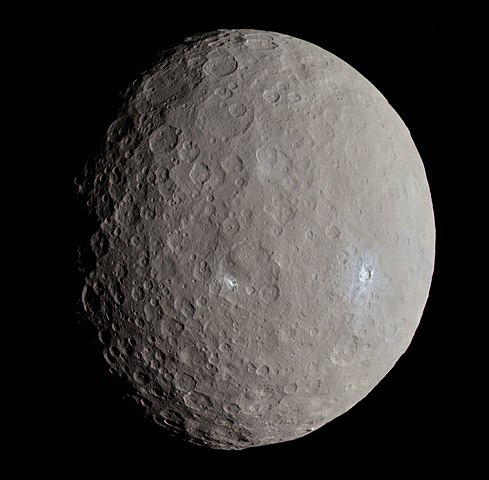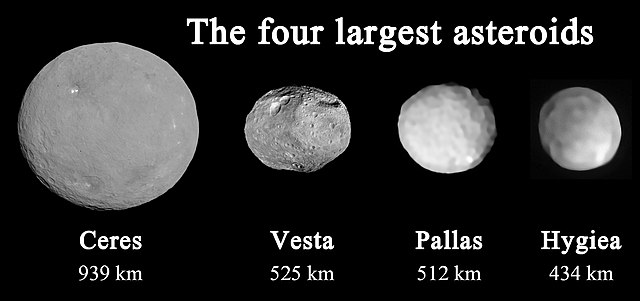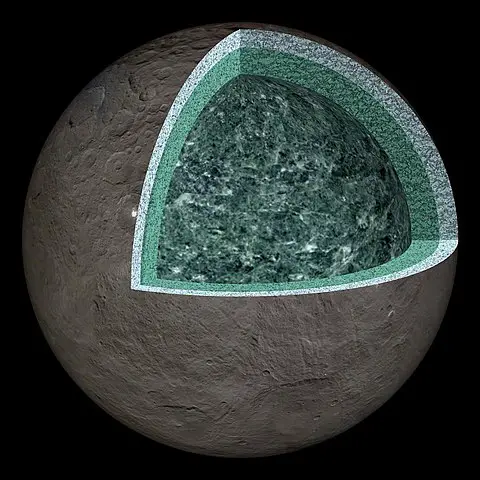Our solar system is home to a host of celestial bodies, including the dwarf planet Ceres. This mysterious body, located in the asteroid belt between Mars and Jupiter, has been the subject of countless studies and explorations since it was first discovered in 1801.
Its enigmatic nature has captivated scientists and the public alike, and its intriguing characteristics have kept us wondering about the mysteries of our solar system for centuries.
Ceres is the closest dwarf planet to Earth, and it is more than double the size of the next largest asteroid in the asteroid belt. Its size and its distinctive round shape are two of its most striking features, making it stand out amongst its peers in the asteroid belt. It also has a very low density and is the only known dwarf planet to have an atmosphere.
Introduction
These characteristics make Ceres a unique and fascinating body in our Solar System and have sparked the interest of scientists and astronomers alike.
The bright spots that have been observed on Ceres’ surface have been the subject of much speculation. Some scientists believe they could be the result of water ice or other kinds of ice, while others believe the spots could be the result of a sublimation process. The bright spots remain a mystery and have been the focus of much research and exploration.
The origins of Ceres have also been an area of fascination and study for scientists. It is believed to have been formed from the same material as the other planets in our Solar System, and its formation and subsequent evolution have been studied extensively.

The crater-filled surface of Ceres has also been studied extensively. The features of these craters provide insight into the geological history of the dwarf planet and offer clues about the activity present on its surface. The presence of ice and other substances on the craters has been the source of much speculation and research.
Finally, the atmosphere of Ceres has been the subject of scientific inquiry for a long time. Its composition and the activity that takes place within it have been studied in detail, and this research has offered us valuable insight into the characteristics of this mysterious body.
Ceres is a fascinating dwarf planet in our Solar System, and its mysterious characteristics and features have captivated scientists for centuries. Its size, shape, composition, and activity have continued to intrigue us, and recent explorations have revealed even more about the unique qualities of this dwarf planet.
In the following sections, we will delve into the history of Ceres, its physical characteristics, its geology, and its atmosphere in order to better understand this mysterious celestial body.
History
Ceres is a dwarf planet located in the asteroid belt between the orbits of Mars and Jupiter. It is the largest body in the asteroid belt, with a diameter of just over 950 kilometers. This mysterious object is of particular interest to scientists due to its unique properties and origin.
The origin of Ceres is a stark reminder of our solar system’s chaotic beginnings. Ceres is believed to have originated from the same primordial material that formed all the planets in the solar system. It is hypothesized that it was once much larger before it was disrupted by the gravitational pull of other nearby objects.
The dwarf planet was discovered in 1801 by the Italian astronomer Giuseppe Piazzi. Piazzi was studying a group of stars and noticed that one of them seemed to be out of place. After more precise measurements, Piazzi determined that the object he had discovered was in fact a planet. He named it Ceres, after the Roman goddess of corn and harvests.
Since its discovery, scientists have made great strides in understanding the physical characteristics of Ceres. The dwarf planet is believed to have a core of rock and ice, surrounded by a mantle of silicate material. It is much smaller than the other planets in our solar system, with a diameter of just over 950 kilometers.
On the surface of Ceres, scientists have observed an abundance of craters, caused by objects such as asteroids and comets colliding with the planet over time. These craters range in size from just a few meters wide to hundreds of kilometers in diameter.
In addition to the craters, scientists have also observed a series of bright spots on the surface of Ceres. While the exact source of these bright spots is still unknown, some believe it could be due to activity from the planet’s interior.
The atmosphere of Ceres is very tenuous, consisting mainly of water vapor and carbon dioxide. Scientists believe that the atmosphere is in a state of constant flux, with new gases being released from the surface, and old gases being replenished by the planet’s interior.
In recent years, a number of missions have been sent to Ceres to further our understanding of the dwarf planet. NASA’s Dawn mission, launched in 2007, has been studying Ceres since 2015. The mission has provided us with valuable data about the planet’s composition and surface features, as well as its unique atmosphere.
The exploration of Ceres has been highly beneficial for scientists, helping them to piece together the planet’s history and gain a better understanding of its unique characteristics. However, many mysteries about Ceres still remain. Additional exploration and research will help to unlock the secrets of this mysterious dwarf planet.

Physical Characteristics
Ceres is the first and largest object in the asteroid belt, located between the orbits of Mars and Jupiter. As a dwarf planet, it has many remarkable characteristics that have attracted interest from scientists and astronomers alike.
In terms of physical characteristics, there are a few aspects of Ceres that make it so unique.
Size of Ceres
Ceres is 590 miles across, making it the largest object in the asteroid belt. This means it is two-thirds the size of the Moon and a quarter the size of Earth.
In comparison, Pluto, the most famous of the dwarf planets, is only about a fifth of the size of Ceres. Because of its size, Ceres has been classified as a dwarf planet by the International Astronomical Union since 2006.
Composition of Ceres
Ceres is composed primarily of rock and ice, with a core composed of a mixture of silicate rock and iron. This composition is similar to other objects, such as Vesta, located in the asteroid belt.
In addition, Ceres is believed to have a mantle of ice and a crust of clay, carbonates, and sulfur.
Surface Features
Ceres’ surface has a number of interesting features. It has two huge impact basins, called Kerwan and Urvara, and is also covered in craters.
There are also several large mountains, the highest of which is Ahuna Mons, reaching a height of 3.3 miles. Lastly, there are a number of bright spots located on Ceres’ surface, which have yet to be explained.
Overall, Ceres’ physical characteristics have been a source of much scientific interest. As the first and largest object in the asteroid belt, its size and composition have made it stand out among other minor planets.
Its unique surface features have also been intriguing to scientists, and its bright spots are still a source of some mystery. With further exploration, we may be able to gain a better understanding of Ceres and all its secrets.
Geology
Ceres, the largest known object in the asteroid belt, has a fascinating geology. Its surface is blanketed with craters of various sizes, providing a glimpse of its history and evolution. The most notable feature on its surface is a number of bright spots, adding to the intrigue of understanding this enigmatic dwarf planet.
These spots, which may be evidence of recent or ongoing geological activity, are still being studied to determine their origin.
Ceres’ craters are believed to have been created by asteroid and comet impacts, though the exact mechanism of their formation is still not fully understood. Its larger craters are thought to have been formed by massive collisions with other asteroids or comets in the asteroid belt, while smaller craters are believed to have resulted from more localized events.
These craters range in size from a few kilometers to hundreds of kilometers across and are believed to range in age from a few hundred million to a few billion years old.
In addition to craters, Ceres has a number of other surface features, including mountains, ridges, canyons, and massifs. These features are believed to be the result of tectonic processes, such as the expansion and contraction of the dwarf planet’s interior. Some of these features are thought to be very recent, while others may have formed millions of years ago.
The mysterious bright spots on Ceres’ surface are still under investigation. Some believe they could be evidence of recent or ongoing geological activity on the dwarf planet, while others suggest that they might be deposits of ice or salt from ancient impacts. In any case, scientists are still trying to determine their origin and composition.
Ceres is also believed to have an icy mantle beneath its surface, which could be evidence of a sub-surface ocean. This could be a source of geological activity, as well as a potential habitat for life. Scientists are continuing to study the possibility of a liquid ocean beneath Ceres’ surface.
Finally, Ceres is thought to have a tenuous atmosphere made up of vaporized water and other volatiles, such as carbon dioxide and nitrogen. This atmosphere is believed to be composed of molecules that are produced by the sublimation of surface ice. Currently, the atmosphere of Ceres is thought to be too weak to be detected directly, but scientists are continuing to investigate its composition and dynamics.
Atmosphere
Ceres has an extremely thin atmosphere, composed mostly of carbon dioxide and nitrogen. This means that it is unable to retain any of the gases that are heavier than nitrogen, including oxygen. Scientists believe that Ceres’ atmosphere was once thicker and more active, but has since thinned due to its low gravity and lack of a strong magnetic field.
Due to the current absence of a thicker atmosphere, scientists are curious if the surface of Ceres holds any clues as to its atmospheric past. As Ceres is thought to have a subsurface ocean of liquid water, there is potential for its atmosphere to hold some of this liquid in the form of mist or vapor.
The current state of Ceres’ atmosphere is difficult to measure, as the spacecraft sent to explore the dwarf planet has so far been unable to detect any signs of an atmosphere. Further exploration is needed to determine the exact composition of the atmosphere and its activity.
Another fascinating characteristic of Ceres’ atmosphere is its darkening. Scientists have observed that the colors of Ceres’ surface become darker when the sun is in its crescent phase, with one-half of the dwarf planet lit up and the other half in darkness. This suggests that Ceres’ atmosphere has a role in the darkening of its surface.
It is likely that during the crescent phase, Ceres’ atmosphere acts like a lens, focusing the sunlight onto the lit-up half of the planet, while the dark side remains in darkness.
The phenomenon of Ceres’ darkening atmosphere is a source of scientific intrigue. Scientists are eager to understand the causes of this darkening in order to get a better picture of the atmosphere and its activity.
The exploration of Ceres’ atmosphere has only just begun. The NASA Dawn spacecraft, which is currently in orbit around Ceres, is sending back valuable data and images of the dwarf planet which may help to shed more light on the atmosphere and its characteristics. Scientists are also planning future missions to explore Ceres and its atmosphere more closely.
The exploration of Ceres’ atmosphere will bring numerous benefits. It will provide more insight into the formation and evolution of planets in the asteroid belt, as well as the potential for life in other asteroids. It will also help scientists to understand the role that atmospheres play in the formation and evolution of planets.
Ceres is a mysterious dwarf planet that continues to baffle scientists. Its atmosphere, which is composed of mainly carbon dioxide and nitrogen, is thin and darkens when the planet is in the crescent phase.

Exploration
Since its discovery in 1801, Ceres has been the subject of much exploration. Several missions have been sent to its vicinity, providing invaluable data about this mysterious dwarf planet.
The Dawn mission, launched by NASA in 2007, was the first mission to Ceres, becoming the first spacecraft to enter orbit around a dwarf planet. During the Dawn mission, a wealth of information was collected about Ceres, including its composition, surface features, and unique bright spots.
The Dawn mission also revealed that Ceres possesses an atmosphere made up of nitrogen, carbon monoxide, and water vapor. Furthermore, the mission showed evidence of surface activity on the dwarf planet, such as the presence of ice volcanoes and other geological features.
Since the Dawn mission, other missions have been sent to further explore Ceres. In December 2018, NASA launched the OSIRIS-REx spacecraft on a mission to collect samples from a small asteroid called Bennu. While on approach to Bennu, the spacecraft made a flyby of Ceres. This flyby provided valuable data on the dwarf planet and its activity, including the discovery of water vapor in its atmosphere.
More missions are currently underway to explore Ceres. In the coming years, the European Space Agency (ESA) will launch the Hera mission to further study the dwarf planet. The mission is planned to launch in 2024 and will make a close flyby of Ceres. During this flyby, the spacecraft will study the gravity and surface of the dwarf planet, as well as analyze its atmosphere.
Overall, the exploration of Ceres has provided invaluable data about this mysterious dwarf planet. It has revealed the presence of an atmosphere, surface activity, and composition of its surface. Exploration of Ceres continues to provide scientists with a better understanding of this small world and its mysteries.
Facts
It was discovered in 1801 by Italian astronomer Giuseppe Piazzi
Ceres was named after the Roman goddess of agriculture
It is the only dwarf planet located in the inner solar system.
Ceres has a surface area comparable to the area of Greenland.
Ceres is the first dwarf planet to receive a visit from a spacecraft.
Ceres accounts for approximately one-third of the total mass of the entire asteroid belt.
Ceres was the first object considered to be an asteroid.
Ceres was classified as a planet for half a century.
It is now classified as a dwarf planet
Ceres is located between Mars and Jupiter.
Studies using Hubble showed graphite, sulfur, and sulfur dioxide on Ceres’s surface.
In 2017, it was confirmed that Ceres has a transient atmosphere of water vapor
Ceres is a surviving protoplanet that formed 4.56 billion years ago
Ceres takes 4.6 Earth years to complete its orbit around the sun.
The Dawn spacecraft found evidence of organic compounds on the dwarf planet.
Ceres has a giant mountain called Ahuna Mons that stands 4 miles high
The surface of the planet has various bright spots.
Ceres is the smallest dwarf planet having a diameter of only 946 km
Ceres is too dim to be seen with the naked eye.
It has 3+1⁄2 times the mass of the next asteroid, Vesta
Altogether, Ceres is approximately 50% water by volume
It seems rather that it formed between the orbits of Jupiter and Saturn
Ceres is rich in carbon, hydrogen, oxygen, and nitrogen
it can be seen with binoculars in a naturally dark and clear night sky around the moon
Information
| Discovered by | Giuseppe Piazzi | ||||||
|---|---|---|---|---|---|---|---|
| Discovery date | 1 January 1801 | ||||||
|
MPC designation
|
1 Ceres | ||||||
| Pronunciation | SEER-eez | ||||||
|
Named after
|
Cerēs | ||||||
|
Minor planet category
|
|
||||||
| Orbital characteristics | |||||||
| Epoch 21 January 2022 (JD 2459600.5 ) | |||||||
| Aphelion | 2.98 AU (446 million km) | ||||||
| Perihelion | 2.55 AU (381 million km) | ||||||
|
Semi-major axis
|
2.77 AU (414 million km) | ||||||
| Eccentricity | 0.0785 | ||||||
|
Orbital period (sidereal)
|
|
||||||
|
Orbital period (synodic)
|
|
||||||
|
Average orbital speed
|
17.9 km/s | ||||||
|
Mean anomaly
|
291.4° | ||||||
| Inclination |
|
||||||
|
Longitude of ascending node
|
80.3° | ||||||
|
Time of perihelion
|
7 December 2022 | ||||||
|
Argument of perihelion
|
73.6° | ||||||
| Satellites | None | ||||||
|
Proper semi-major axis
|
2.77 AU | ||||||
|
Proper eccentricity
|
0.116 | ||||||
|
Proper inclination
|
9.65° | ||||||
|
Proper mean motion
|
78.2 deg/yr | ||||||
|
Proper orbital period
|
4.60358 yr | ||||||
|
Precession of perihelion
|
54.1 arcsec/yr | ||||||
|
Precession of the ascending node
|
−59.2 arcsec/yr | ||||||
| Physical characteristics | |||||||
| Dimensions | (966.2 × 962.0 × 891.8) ± 0.2 km | ||||||
|
Mean diameter
|
939.4±0.2 km | ||||||
|
Surface area
|
2,772,368 km2 | ||||||
| Volume | 434,130,000±500,000 km3 | ||||||
| Mass |
|
||||||
|
Mean density
|
2.1616±0.0025 g/cm3 | ||||||
|
Equatorial surface gravity
|
|
||||||
|
Moment of inertia factor
|
0.36±0.15(estimate) | ||||||
|
Equatorial escape velocity
|
0.516 km/s 1141 mph | ||||||
|
Sidereal rotation period
|
9.074170±0.000001 h | ||||||
|
Equatorial rotation velocity
|
92.61 m/s | ||||||
|
Axial tilt
|
≈4° | ||||||
|
North pole right ascension
|
291.42744° | ||||||
|
North pole declination
|
66.76033° | ||||||
|
Geometric albedo
|
0.090±0.0033 (V-band) | ||||||
|
|||||||
|
Apparent magnitude
|
|
||||||
|
Absolute magnitude (H)
|
3.34 | ||||||
|
Angular diameter
|
0.854″ to 0.339″ | ||||||

